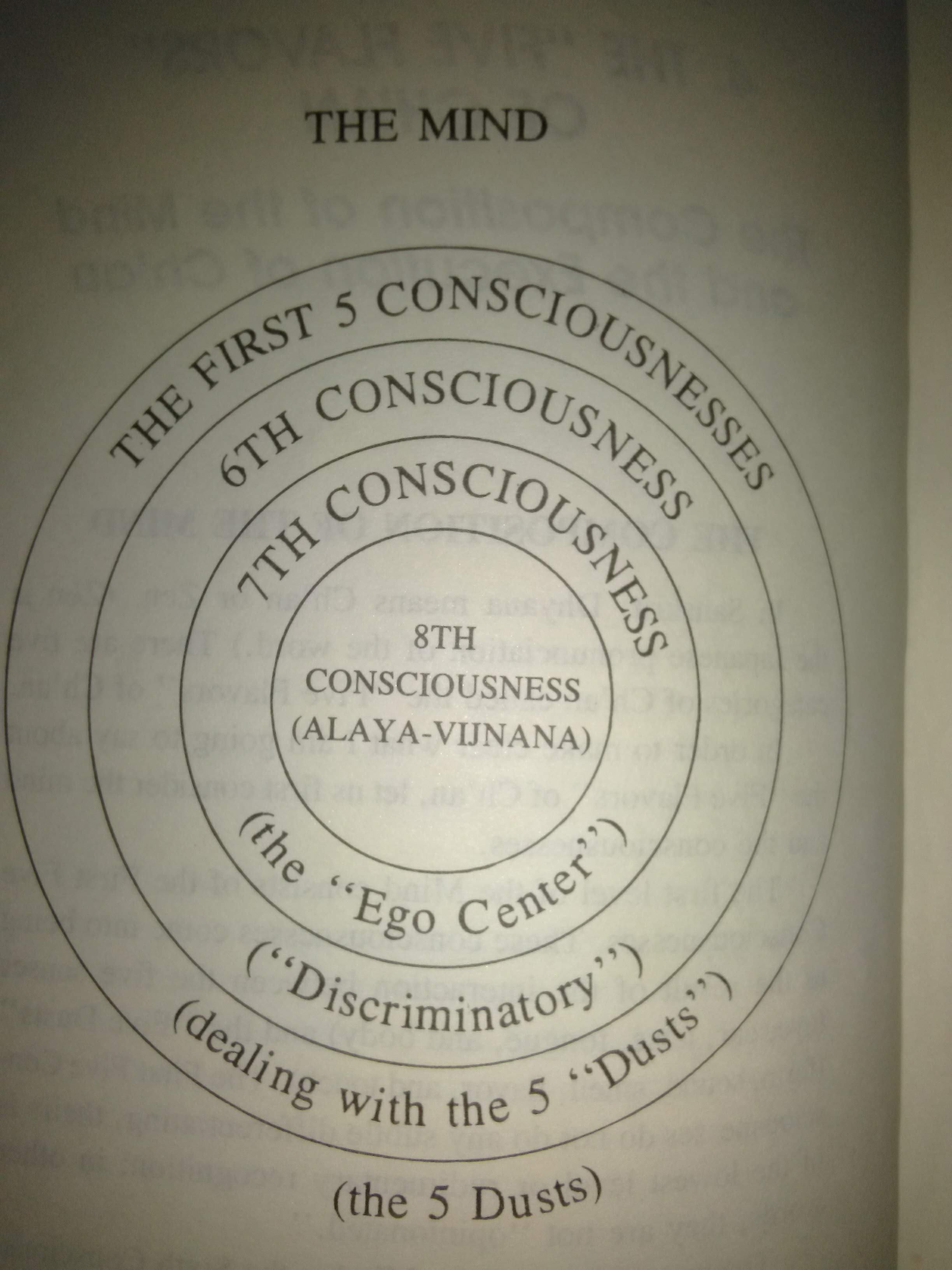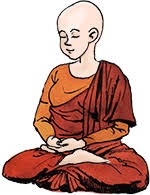The Composition of the Mind
 Shoshin
No one in particularNowhere Special Veteran
Shoshin
No one in particularNowhere Special Veteran
Just thought that some may find this of interest.....
"To the Mind that is still the whole universe surrenders"
~Lao Tzu~
According to Thich Nhat Hanh ( in brief )
In fact, says Thich Nhat Hanh, identifying the different elements of consciousness, and understanding how they interact, is essential to our practice of meditation.
The Buddha taught that consciousness is always continuing, like a stream of water. Consciousness has four layers. The four layers of consciousness are mind consciousness, sense consciousness, store consciousness, and manas.Mind consciousness is the first kind of consciousness. It uses up most of our energy. Mind consciousness is our ‘working’ consciousness that makes judgments and plans; it is the part of our consciousness that worries and analyses.
The second level of consciousness is sense consciousness, the consciousness that comes from our five senses: sight, hearing, taste, touch, and smell. We sometimes call these senses ‘gates,’ or ‘doors,’ because all objects of perception enter consciousness through our sensory contact with them.
The third layer of consciousness, store consciousness, is the deepest. There are many names for this kind of consciousness. Mahayana tradition calls this store consciousness, or alaya,
In Vietnamese, we call store consciousness tang. Tang means to keep and preserve.
It’s an illusion that we are free. The degree of freedom that our mind consciousness has is actually very small. Store consciousness dictates many of the things we do, because store consciousness continuously receives, embraces, maintains, processes, and makes many decisions without the participation of mind consciousness. But if we know the practice, we can influence our store consciousness; we can help influence how our store consciousness stores and processes information so as to make better decisions. We can influence it.Store consciousness is also a victim. It’s an object of attachment; it’s not free. In store consciousness there are elements of ignorance—delusion, anger, fear—and these elements form a force of energy that clings, that wants to possess. This is the fourth level of consciousness, called manas, which I like to translate as ‘cogitation.’ Manas consciousness has, at its root, the belief in a separate self; the belief in a person. This consciousness, the feeling and instinct called ‘I am,’ is very deeply seated in store consciousness. It’s not a view taken up by mind consciousness. Deeply seated in the depths of store consciousness is this idea that there is a self that is separate from non-self elements. The function of manas is to cling to store consciousness as a separate self.
The full article "The Four Layers of Consciousness"
However Reverend Cheng Kuan has a slightly different take on the composition of the Mind...
"The Sweet Dews of Ch'an"

The Composition of the Mind
In Sanskrit, Dhyana means Ch’an or Zen. (Zen is the Japanese pronunciation of the word.) There are five categories of >Ch’an called the “Five Flavors” of Ch’an.In order to make clear what I am going to say about the “Five Flavors” of Ch’an, let >us first consider the mind and the consciousnesses.The first level of the Mind consists of the First Five Consciousnesses. These consciousnesses come into being as the result >of the interaction between the five senses (eye, ear, nose, tongue, and body) and the “Five Dusts” (form, sound, smell, >flavor, and touch). The First Five Consciousnesses do not do any subtle differentiating, theirs is of the lowest level or >rudimentary recognition;in other words, they are not “opinionated.”
The second level of the Mind is the Sixth Consciousness — it is this consciousness that operates all the sophisticated >differentiatings. This is, consequently, the judgemental and rational level of our Mind. It ponders, weighs and discriminates >upon the images of the Five Dusts collected by the five senses. This level of our Mind tends to consider itself as the “boss;” >that is, it “thinks” it is “in control.” But, as a matter of fact, it merely takes orders from someone else — the Seventh >Consciousness.
However, the Sixth Consciousness is able to rationalize and make all sorts of justifications for its hidden commander, the >Seventh Consciousness. Therefore, the Sixth Consciousness is somewhat like a middleman in that it gratifies in a most >delicate way the desires of the next level, the Ego, or the Seventh Consciousness.The third level of our Mind is the Seventh Consciousness, the Ego Center. This is the so-called “I,” which has itself >expressed in the daily world via the Sixth Consciousness. This also is the level which determines how the first six levels >above will react to the external world — i.e. they all do its biddings. Nevertheless, we are unable to see this Ego, because >we have covered it up with all sorts of excuses and rationalizations furnished by the “foreman,” the Sixth Consciousness.
The fourth level of the Mind under the Ego Center is the Eighth Consciousness, also called “Alaya Vijnana” (“Alaya” meaning >storage). This is the storage house of consciousness, the big dumpster for all people.
The First Five Consciousnesses together with the Sixth enable us to function, or take actions in our daily life. Eventually, >those actions of ours, if repeated a few times over, will form into habits and are thus pressed down into the Seventh and >then the Eighth level of consciousness. Once they reach the Eighth level, they can resurface when we least expect them and >in such ways that can startle us. And those same unexpected “somethings” are sometimes mysteriously called >“inspirations.”
Under suitable situations, what resides in the Eighth Consciousness will emerge. This does not only occur in
our waking life, but also in our dreams — so far as Freud 19 20 is concerned, it does so mostly in our dreams.
Habits are at once a blessing and a curse to us — a blessing, because without them life is almost impossible;\ if we had to >think about literally everything before we did it, we would be in tremendous hardships — a curse, for they can enslave us. >[Example of how the habit of smoking is brought down into Seventh and Eighth levels and becomes a “habit” is given by >the Reverend at thispoint.]
Everything we do is called “Karmas,” or actions. (There are three kinds of karmas: body karma, speech karma, and mental >karma.) In our conscious mind, our deliberate actions, when done, are pressed down to the unseen level beneath, and >collected and made ready for use there, like ready-made suits or a drive-through hamburger restaurant, to the effect that >we really do not need to think about what we are doing anymore; we just act through habits. In other words, on a larger >scale, we are being carried by our previous Karmas, which are so abstruse that they are far beyond our imagination or >thinking, and in a given situation they will just spring into view in an almost inexplicable manner.
Food perhaps, for the Mind to ponder...Hmm I don't Mind if I do 




Comments
This sort of stuff is interesting to me. When I was in the Tibetan tradition there was more emphasis on these matters, I'm feeling drawn back to them.
The above descriptions seems to run parallel to how I kind of think of the subconscious mind and the source of deeply ingrained habits and gut feelings.
I'm not that well versed on this but I'm pretty sure the Tibetans, at least in the Gelug school, reject the notion of alaya consciousness and say there are only 6 or 7 levels. If memory serves the distinction is in the schools of thought of yogacara (that believes in alaya) and madhyamika (that doesn't). I have a book on this, Cutting Through Appearances, that I haven't read yet and have been eyeing it thinking of picking it up, maybe I will now.
Yes @person... I too find it very interesting ...it's fascinating to explore
It's truly amazing...we use components of our mind to explore the contents of our mind and how it functions... and the subject matter is readily available to explore 24/7 ....
"The most essential method which includes all other methods is to behold the Mind-The Mind is the root from which all things grow...If one can understand the Mind ....Everything else is included"
~Bodhidharma~
And...
When we understand how our mind works, our practice becomes easy.
~Zen Master, Thuong Chieu~
This sums up my fascination about the wonderful Mind
Well the song's lyrics could easily relate to the Mind... ;)
;)
Don't do donuts.
I asked someone on another forum “where do thoughts come from?” He replied “where does fire come from?” Which I thought was a particularly beautiful answer as it points the way very nicely.
The general idea is that when there is a trigger and conditions are right, a thought will manifest and a little while later cease to be. A trigger can come from the senses or from another thought, while conditions will include natural inclinations, habits, concepts and past events.
It certainly illuminated my way of viewing the generation of thoughts.
Good point. I've often toyed with this. Among the 5 aggregates, I feel the most significant one is samkhara. (habitual tendencies, latent impressions). The other one being vedana or sensation. Normally when we say thoughts in the context of meditation, we most likely mean thoughts infused with feeling (vedana), or habitual thought patterns (samkharas). Random thoughts that don't bother us are left alone - they just arise and fade. Dealing with samkharas and vedanas - I think that's the real object of meditation, as not only are they interdependent but also extremely powerful and persistent.
All this is IMO. Feel free to disagree.